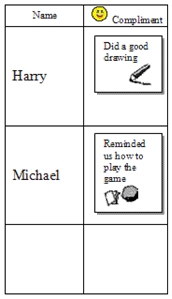User login
Description:
To be given and receive compliments.
| Early years skill: | not specified |
| Early years typical range: | not specified |
| P-scales/Curriculum skill: | PSHE and Citizenship |
| P-scales/Curriculum level: | L1 |
| TAP skill: | Social Interaction |
| TAP level: | TAP60 |
| Pre/Nat. Curriculum Area: | not specified |
| Pre/Nat. Curiculum Standard: | not specified |
| Phoenix Area: | not specified |
| Phoenix Step: | not specified |
| Section: | Primary (5-11yrs) info |
| Activity/strategy name and materials required | How to do the activity | Key principles for doing the activity and comments |
|---|---|---|
| Brainstorm | Ask the children "what is a compliment? What should you do if someone gives you a compliment?" | You could also talk about "what is criticism?" and "is criticism always bad?" |
| Act it out 'Teen-age' rag dolls | The children could act out giving and receiving criticism. | |
| Give a compliment Cards with names of everyone in the group (including adults) | Take out the name of the person you're offering the cards to, so they can't choose themself. | |
| Compliments Chart Giving and receiving compliments as part of a language group. This is a good way to boost children's self esteem. Materials: Compliment prompt cards, with or without visual support, as appropriate. Compliments chart, with each child's name on the left side, with a space on the right side for the chosen compliment to be stuck. For example:
Blu-tac to stick the compliment cards on to the chart, and the chart on to the wall. | You will need to explain what a compliment is - a positive comment about another person that makes them feel good. It needs to be genuine! You can keep a note of the compliments each child is given over all the sessions of the group. They can get a certificate / note at the end with all their compliments on for them to keep. You can use this with younger children if you help them to think about what a compliment is. If they find it difficult you can make it easier by asking them to 'say something nice' to the person next to them. | |
| Compliments web Ball of string Compliments prompt cards if appropriate. | You will need to explain what a compliment is - a positive comment about another person that makes them feel good. It needs to be genuine! You can use this with younger children if you help them to think about what a compliment is. If they find it difficult you can make it easier by asking them to 'say something nice' to the person next to them. |
Support Commtap to keep it online
Thank you for visiting Commtap.
Please read this message as it is extremely important.
- Visitor donations mean we can continue to host over 1,000 free activities to support speech, language, and communication development.
- Visitor donations mean we can continue to provide free resources to address a wide range of communication needs, including limited speech or language, interaction challenges, and needs associated with conditions such as developmental language disorder, autism, and cerebral palsy.
- Visitor donations mean we can continue to provide resources to support the work of speech and language therapists, teachers, teaching assistants, parents, and carers.
- Visitor donations mean we can continue to provide the free key word sign dictionary (bks.org.uk) which has over 2,000 Makaton and Signalong signs.
We know that not everyone is able to afford to pay to access these resources, however, if you can, please make a donation to keep the site going.
Thank you
Google ads on this page are provided by Google Adsense - and their presence does not imply any endorsement by Commtap. Report a problem with an ad on this page. Log in (for free) to avoid seeing Google ads.

